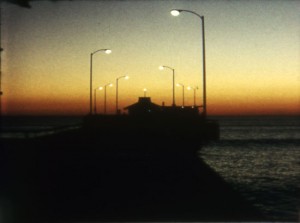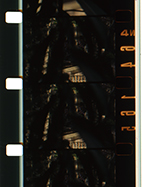Past New Releases: Spring 2009
Posted April 27th, 2010 in New Acquisitions

New Releases from the Spring of 2009.
Works now available on DVD by..
Colin Vincent’s work is embedded in a psychic temporal space where he tries to tap in to the inner emotional response of his audience.
Best known for his film ‘Intestinal Fortitude’ (’91) and ‘Unbearable Being’, Colin has been creating award-winning abstract experimentally animated films for over 17 years, and has created over ten 16mm shorts. Raised in suburban Boston and a Silicon Valley native, Colin’s art films are tainted with a political satire and intense optical layering and have screened worldwide in festivals and museums (MoMA, Museum of Fine Arts Boston, Pompidou Center, Ann Arbor Film Festival, London International Animation Festival, among others).
BFA Film, Massachusetts College of Art ’93
MFA Experimental Animation at California Institute of the Arts ’98
www.mediumstrip.com
colinbarton@mindspring.com
Sound by Crank Sturgeon
Screening history:
October 2006 – Berkeley Film and Video Festival – Best Experimental Film
March 2007 – Ann Arbor Film Festival – and Tour
August 2007 – Seoul, Korea – Exis International Film and Video Festival
March 2008 – $100 Film Festival, Calgary, CANADA (first 16mm screening)
This is a eulogy to lost friends, either by death or disassociation. River Phoenix appears as the archetypal figure of my generation. This film lives in a space of a junkie’s death walk, and their final exit from the earth.
Hand-painted 35mm original with optical printing are at the source of this work; with a little help from an electric toothbrush and washing machine. (CVB)
2006/2008, 16mm, color/so, 5m, $25
“I had one of my graduate students drive the car, and I filmed 16mm
black and white negative driving through these four consecutive tunnels on the Pasadena freeway. I wound up doing about 1400 paper prints from the individual frames in the negative. I mounted a piece of glass in my garage, with a square of tape marked out on it. I sat down behind the glass with a white T-shirt on and started shooting the stills. My wife Sarah shot the first part, and as the shots got shorter and shorter, I shot it myself using a bulb hooked up to the camera that I operated with my foot. I originally meant to shut it off and fade it out to end it, but while I was shooting, I decided instead to reverse the procedure, slowing the shots back down. I called Sarah back to shoot the last part. I always had the idea of sound, but I could never figure out what the heck kind of sound to have in this film.” (Gary Beydler, 2008)
“Possibly the most lucid, vivid, and awesome demonstration of the building up of still images to create moving ones, Pasadena Freeway Stills simply, gracefully and powerfully shows us the process by which we are fooled by the movies. By doing so, Gary Beydler mines a very rich vein of associations and metaphor, without the slightest ostentation.
“Constructed as a thrilling arc of realization and, in a quite moving way, disappointment, the film is a beautiful articulation of our emotional entanglement with moving images, while simultaneously creating a form in which the illusion of cinema is brought into incredible relief as the film we’re watching gradually catches up to the film Gary is holding up to the camera with his hands, one frame at a time.” (Mark Toscano)
1974, 16mm, color/silent, 6 min. $40
Venice Pier
“I wanted to make a film that was exactly one year in the making. I love the ocean, and I decided to shoot on the Venice Pier, which was about a quarter mile long. About every ten feet, there are divisions in the pier, which I decided to use as the shooting points. I made a drawing of the pier on vellum, marking out these divisions.
“I started shooting maybe in November or December, and shot it all the way through to the following year, finishing on the same date. I shot in all the different seasons, different times of day, filling in the blanks on the drawing I made of the pier. It was shot out of order – watching the film, you’re moving forward every so slowly, through different times, different seasons, different situations. Sometimes you get the feeling of movement, sometimes you don’t. No need for staging, I just shot things that were happening.
“When it was finished, I presented it for about a month at Gagosian gallery. We built a wall with a glass partition, through which you could see the film. Sometimes one person would walk in, sometimes forty, sometimes nobody. The film was projected continuously for the show. The drawing of the pier was hanging vertically in the gallery, along with some of my mirror pieces, which were popular at the time.
“This was my last film. I loved the film, and was very happy with it, but it wasn’t received very well. Everyone seemed to ignore it. So I thought, ‘Well, what the hell, I’ll move on.'” (Gary Beydler, 2008)
“Gary Beydler’s last, and possibly least-seen, film is an exhilarating tour down the length of the Venice Pier, shot over the course of an entire year. It’s a particularly cinematic walk in many ways. Gary investigates the way a single film stock responds so diversely to different seasons, light, weather, time of day. He also beautifully exploits the power of editing to compose or recompose events. Shot spatially out of order over the course of a year, Gary recomposed the footage in editing to make it proceed consistently forward in space, resulting in an intricate mixing up of chronology, so some cuts could represent a jump of months either forward or backward in time. The result is one of gauzy impressionism brought into vivid and breathtaking clarity.” (Mark Toscano)
1976, 16mm, color, sound, 16 min. $80
Tunnels
“The outside of the inside by candlelight or, the mice into the snake, as it were. The film takes an average viewer and turns them into a voyeur of the nearly, though not quite, expected. The beauty of partial understanding serves as its currency, though we should not get too preoccupied by the transactions between scenes or characterizations to the demise of entertaining an all-too-rare claustrophobic everynight that unfurls in time lapse and predatory recoil. That is the texture of Tunnels – not a surface at all, but a flickering window to the jerky, dark terror of movement and sound through which we are allowed passage. By the final scene I had been freed of a concern over what any of it meant, for once.”
-Alan Flurry, Flagpole Magazine
2009, 16mm b&w/color, sound, 10 min. $40
Go Go Go
preserved by Anthology Film Archives
Taken from a moving vehicle, for much of the footage. The rest uses stationary frame, stop-motion. In the harbor sequence, I had to wait for the right amount of activity, to show effectively the boats darting about; some sequences took over an hour to shoot, and last perhaps a minute on the screen. The “strength and health” sequence was shot at a body beautiful convention. Various parts of the city of New York, the busy man’s engrossment in his busy-ness, make up the major part of the film … a tour-de-force on man’s activities.
1962-1964, 16mm, color/silent, 11.5m (24fps), $45
By the Sea
Newly preserved by Academy of Motion Picture Arts and Sciences
In collaboration with Robert Abel
Pat O’Neill’s first film.
“O’Neill began filmmaking as an extension of photography with a “documentary” By the Sea (1962), co-produced with Bob Abel (who later became famous for his advertising films), for the finale of which O’Neill printed images of beach activities on high-contrast film for a dazzling sun effect, and edited them in crisp dynamic rhythms.” (iotaCenter)
1963, b/w, so, 10min. $45
The Wofobs
A deceptively (?) stupid commentary on the disposability of information
in this, the dawning of a bold new era of thinly spread knowledge and
vastly dispersed and diluted communication that becomes increasingly
abstract, superficial, and disengaged with every passing day that we
continue to allow things like mobile billboard trucks to exist.
2008, 16mm, color, sound, 4min. $25
Works now available on DVD
Bruce Baillie DVD Volume 1 is now available for sale, includes Tung, Mass for the Dakota Sioux, Valentin de las
Sierras, Castro Street, and All My Life. These are newly restored versions of each title.
DVD, $300 for institutions, and $50 for home use. Postage $8 domestic and $13 for international shipments. Payment can be made by check, money order, PayPal (films@canyoncinema.com), or Visa/Mastercard.
The Sweet New
The Sweet New raises concerns about authenticity by following change in three generations of an Italian-American family. In the first generation there is an emigration story as an Italian man emigrates only to be interned as an enemy alien. (This is based on a true story.) In the second generation the change is an assimilation, made palpable through a name change. The third generation contains another name change and a corresponding gender change. In the end communication is aided by a letter from a friend of the family.
Super 16mm on DVD for sale: $50 individuals/ $175 institutions; color, 60 min.
Lynne Sachs’ personal web site: www.lynnesachs.com
Lynne Sachs: 10 Short Films and Videos
Film and Videos on DVD
“XY Chromosome Project” 12 min. 2007
“The Small Ones”, 3 min. video 2006
“Noa, Noa”, 8 min. 16mm, 2006
“Atalanta 32 Years Later” 5 min. video, 2006
“Tornado”, 4 min. video 2002
“Photograph of Wind” 4 min. 16mm, silent, 2001
“Window Work” 9 min. video, 2000
“Following the Object to Its Logical Beginning”, 9 min. 16mm. 1987
“Still Life With Woman and Four Objects”, 4 min. B&W 16mm., 1986
“Drawn and Quartered”, 4 min. color 16mm., 1987
“Lynne Sachs is best known for her spirited and lyrical essay films—films defined by an unwavering woman’s inflection and a commitment to pry the cracks in official history. However, throughout Sachs’s career, we’ve been treated to a succession of short experimental works that tease out the details of the everyday with the same clarity of vision and instinct for the hand-nurtured image as her much-lauded lengthier works. These films and videotapes, whether they be mystified glimpses of childhood, reinventions of films past, or formal excursions into the poetic, surrender the wonder of a world seen by an artist with a soulful eye and a conscientious heart.”
–Steve Seid, Film-Video Curator, Pacific Film Archive
“Equal parts humanist and formalist, poet and historian, telling tales that are both timeless and political, Lynne Sachs creates film worlds in which the textures of daily domestic life are seamlessly connected to the realms of war, political activism, and our response to terrorist attacks. In one film, a grid becomes a secret map for understanding the difference between male and female. In another, an affectionate portrait of her young daughter becomes a study of whirling circular energy. For each of these ten shorts, Sachs creates a unique film language, by weaving together images, sounds, and words that evoke a particular way of viewing the world. All of these works reveal a sensibility that refuses to flatten either life or art, insisting on a multilevel reality in which the personal and the universal become doorways to a broader consciousness.”
–David Finkelstein, writer for filmthreat.com
“Sachs suspends in time a single moment of her daughter.”
— Fred Camper, Chicago Reader
“Very gentle and evocative of foreign feelings.”
–George Kuchar, filmmaker
“Profound, the soundtrack amazing….the image of the girl with the
avocado seed so hopeful.”
–Barbara Hammer, filmmaker
“In Sachs’s theatrical, microcosmic worlds, the everyday is
defamiliarized. Objects — toys, hands, a cherry pie, a miniature
Empire State Building — resonate and tremble.”
-Bosko Blagojevic, Flavorpill.net
Selected Screenings:
TriBeca Film Festival, San Francisco Film Festival, Black Maria Film
Festival, Ann Arbor Film Festival, Tate Museum of Art London,
Whitney Museum of Art
1987-2007, 65 min., DVD Sale, $20 Individuals, $175 institutions.


